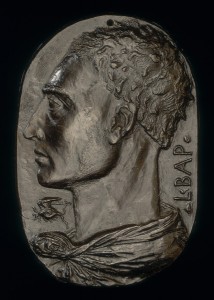
Attributed to Andrea Mantegna or Gian Marco Cavalli
Funerary Monument of Andrea Mantegna, installed by 1516
Bronze on porphyry framed by Istrian stone
Chapel of San Giovanni Battista, S. Andrea, Mantua, Italy
Scala/Art Resource, NY
The ultimate expression of Mantegna’s engagement with antiquity is found in the commemorative monument he designed for himself in the church of Sant’Andrea in Mantua. Emulating a format frequently employed by Roman emperors, the monument features a bronze bust (in this case, a self-portrait of the artist) crowned by a wreath of gilded laurel leaves and set against a round plaque of purple porphyry stone. The accompanying inscription compares Mantegna with the most famous painter of antiquity: “You who see the bronze images of Andrea Mantegna know him to be equal, if not superior to Apelles.” The inscription echoes verses in Mantegna’s honor, composed in 1497 by Battista Spagnoli (1448–1516):
Why gaze at statues of Myron and Lysippus? Why do the breathing marbles of Praxiteles and the statues of Euphranor delay your step? All the ivory of Phidias is overmatched. The genius of Polycletus is tarnished and loses all luster when compared to the genius of Andrea.7
The confident comparison of modern artists with their formidable ancient precursors had developed into a standard literary trope over the course of the fifteenth century. These rhetorical displays of self-assured bravura—in which moderns claimed equality with, or even superiority to, the legendary painters and sculptors of the past—were symptomatic of the Renaissance response to the heritage of antiquity. Rather than indulge in feelings of inadequacy when faced with the daunting achievements of ancient culture, Italian artists and their apologists adopted a spirit of competitive emulation.

Leon Battista Alberti
Self-Portrait, c. 1435
Bronze, 20.1 x 13.6 cm (7 15/16 x 5 5/168 in.)
National Gallery of Art, Washington, DC, Samuel H. Kress Collection
Image courtesy of the Board of Trustees, National Gallery of Art
Leon Battista Alberti articulates this mode of thinking in the preface to his treatise On Painting, confessing: “I used to marvel and at the same time to grieve that so many excellent and superior arts and sciences from our most vigorous antique past could now seem lacking and almost wholly lost.” On returning to Florence after a long absence, however, he discovered artists who seemed capable of rivaling their ancient forebears. In his view, they possessed “a genius for every praiseworthy thing. For this they should not be slighted in favor of anyone famous in antiquity in these arts.”8 Alberti could rank himself among those with “a genius for every praiseworthy thing.” Painter, sculptor, and architect, he wrote influential treatises on each of those disciplines and also excelled in the fields of law, philosophy, mathematics, and science. He demonstrated both his admiration of classical antiquity and his rivalrous challenge to the ancients in a self-portrait medal of c. 1435. Imitating the severe style of carved gems from the Republican period of Rome, Alberti represented himself in stark profile, cloaked in loose folds suggestive of classical drapery.
Other artists followed Alberti in seeking to identify themselves as heirs to the classical tradition. They appropriated ancient models not only in their work but also as a means of defining themselves. In assertive acts of self-fashioning, the Venetian sculptors Giovanni Boldù (active c. 1454–c. 1477) and Vittore Gambello (1460–1537) created self-portrait medals designed in emulation of ancient Greek and Roman coins. Boldù represented himself in the guise of a Greek hero, nude and with an ivy wreath binding his curly hair.
A Greek inscription identifies him as “Ioannis Boldù, painter of Venice.” Gambello imitated a portrait type used for the Emperor Augustus. The obverses of both medals showcase the artists’ skill in translating classical motifs into inventive new forms.
These artistic manifestations of rivalry with the ancients had numerous literary equivalents. In his poem “On Giving Praise to the City of Florence” (1488), Ugolino Verino (1438–1516) offered a lengthy panegyric comparing Florentine artists (such as Andrea del Verrocchio, Sandro Botticelli, and Donatello) with famous Greek painters and sculptors (Phidias, Apelles, Scopas, and Praxiteles). Making note of the fulsome praise lavished on artists in ancient Greece, Verino contemplated the reaction of a writer from antiquity were he to be transported magically to fifteenth-century Florence:
But now if [the Greek poet] were to see all the painters of this age,
How Greece would have sung their praises, when
Florence bore as a parent, in one century,
These whom I choose to equal with the Greeks.9
In imagining the experience of an ancient transported to the modern world, Verino neatly reversed the usual direction of fifteenth-century time travel, in which the modern, full of praise and wonder, immersed himself in the lost world of antiquity.
![Vittore Gambello<br /><i>“Augustus” (Self-Portrait)</i> [obverse]; <i>Male Figure and Winged Caduceus</i> [reverse], probably c. 1510/1530<br />Bronze, diameter 2.9 cm (1 1/8 in.)<br />National Gallery of Art, Washington, DC, Samuel H. Kress Collection<br />Image courtesy of the Board of Trustees, National Gallery of Art](http://italianrenaissanceresources.com/wp-content/uploads/2012/12/RP_187-300x142.jpg)
![Giovanni Boldù<br /><i>Self-Portrait</i> [obverse]; <i>The Artist with the Genius of Death</i> [reverse], 1458<br />Bronze, diameter 8.5 cm (3 3/8 in.)<br />National Gallery of Art, Washington, DC, Samuel H. Kress Collection<br />Image courtesy of the Board of Trustees, National Gallery of Art](http://italianrenaissanceresources.com/wp-content/uploads/2012/12/RP_180-300x140.jpg)